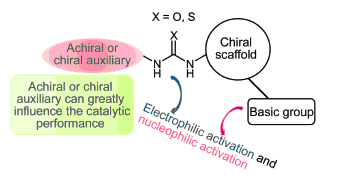| [1] (a) Taylor, M. S.; Jacobsen, E. N. Angew. Chem., Int. Ed. 2006, 45, 1520. (b) Connon, S. J. Chem. Eur. J. 2006, 12, 5418. (c) Doyle, A. G.; Jacobsen, E. N. Chem. Rev. 2007, 107, 5713.
[2] Sigman, M. S.; Jacobsen, E. N. J. Am. Chem. Soc. 1998, 120, 4901.
[3] Okino, T.; Hoashi, Y.; Takemoto, Y. J. Am. Chem. Soc. 2003, 125, 12672.
[4] (a) Wu, Q.-H.; Gao, Y.-J.; Li, Z.; Wang, J.-M.; Wang, C.; Ma, J.-J.; Song, S.-J. Chin. J. Org. Chem. 2007, 27, 1491 (in Chinese). (吴秋华, 高勇军, 李芝, 王俊敏, 王春, 马晶军, 宋双居, 有机化学, 2007, 27, 1491.) (b) Miyabe, H.; Takemoto, Y. Bull. Chem. Soc. Jpn. 2008, 81, 785. (c) Yu, X.; Wang, W. Chem. Asian J. 2008, 3, 516. (d) Takemoto, Y. Chem. Pharm. Bull. 2010, 58, 593. (e) Sohtome, Y.; Nagasawa, K. Synlett 2010, 1. (f) Chai, Z.; Zhao, G. Catal. Sci. Technol. 2012, 2, 29. (g) Lu, L.-Q.; An, X.-L.; Chen, J.-R.; Xiao, W.-J. Synlett 2012, 490. (h) Hou, X.-H.; Ma, Z.-W.; Wang, J.-L.; Liu, H.-M. Chin. J. Org. Chem. 2014, 34, 1509 (in Chinese). (侯学会, 马志伟, 王建玲, 刘宏民, 有机化学, 2014, 34, 1509.)
[5] (a) Connon, S. J. Chem. Commun. 2008, 2499. (b) Siau, W. Y.; Wang, J. Catal. Sci. Technol. 2011, 1, 1298. (c) Tsakos, M.; Kokotos, C. G. Tetrahedron 2013, 69, 10199. (d) Serdyuk, O. V.; Heckel, C. M.; Tsogoeva, S. B. Org. Biomol. Chem. 2013, 11, 7051. (e) Zhang, Z.-G.; Schreiner, P. R. Chem. Soc. Rev. 2009, 38, 1187.
[6] (a) Zhang, Z.-H.; Dong, X.-Q.; Teng, H.-L.; Tao, H.-Y.; Wang, C.-J. Chin. Sci. Bull. 2009, 54, 3407 (in Chinese). (张志海, 董秀琴, 滕怀龙, 陶海燕, 王春江, 科学通报, 2009, 54, 3407.) (b) Fang, X.; Wang, C.-J. Chem. Commun. 2015, 51, 1185. (c) Narayanaperumal, S.; Rivera, D. G.; Silva, R. C.; Paixão, M. W. ChemCatChem 2013, 5, 2756.
[7] Lippert, K. M.; Hof, K.; Gerbig, D.; Ley, D.; Hausmann, H.; Guenther, S.; Schreiner, P. R. Eur. J. Org. Chem. 2012, 5919.
[8] Wei, Q.; Gong, L.-Z. Org. Lett. 2010, 12, 1008.
[9] He, T.; Qian, J.-Y.; Song, H.-L.; Wu, X.-Y. Synlett 2009, 3195.
[10] Ban, S.-R.; Zhu, X.-X.; Zhang, Z.-P.; Li, Q.-S. Eur. J. Org. Chem. 2013, 2977.
[11] Yu, L.; Li, P.-F. Tetrahedron Lett. 2014, 55, 3697.
[12] Li, J.; Yang, G.-X.; Cui, Y.-C. J. Appl. Polym. Sci. 2011, 121, 1506.
[13] Li, J.; Yang, G.-X.; Qin, Y.-Y.; Yang, X.-R.; Cui, Y.-C. Tetrahedron: Asymmetry 2011, 22, 613.
[14] Miura, T.; Nishida, S.; Masuda, A.; Tada, N.; Itoh, A. Tetrahedron Lett. 2011, 52, 4158.
[15] Tuchman-Shukron, L.; Miller, S, J.; Portnoy, M. Chem. Eur. J. 2012, 18, 2290.
[16] (a) Tsogoeva, S.-B.; Wei, S. Chem. Commun. 2006, 1451. (b) Yalalov, D. A.; Tsogoeva, S. B.; Schmatz, S. Adv. Synth. Catal. 2006, 348, 826.
[17] Wang, Y.-F.; Zhang, W.; Luo, S.-P.; Li, B.-L.; Xia, A.-B.; Zhong, A.-G.; Xu, D.-Q. Chem. Asian J. 2009, 4, 1834.
[18] Rao, K. S.; Trivedi, R.; Kantam, M. L. Synlett 2015, 221.
[19] Durmaz, M.; Sirit, A. Tetrahedron: Asymmetry 2013, 24, 1443.
[20] Lalonde, M. P.; Chen, Y.-G.; Jacobsen, E. N. Angew. Chem., Int. Ed. 2006, 45, 6366.
[21] Lalonde, M. P.; McGowan, M. A.; Rajapaksa, N. S.; Jacobsen, E. N. J. Am. Chem. Soc. 2013, 135, 1891.
[22] Kokotos, C. G.; Kokotos, G. Adv. Synth. Catal. 2009, 351, 1355.
[23] Liu, K.; Cui, H.-F.; Nie, J.; Dong, K.-Y.; Li, X.-J.; Ma, J.-A. Org. Lett. 2007, 9, 923.
[24] Lu, A.-D.; Gao, P.; Wu, Y.; Wang, Y.-M.; Zhou, Z.-H.; Tang, C.-C. Org. Biomol. Chem. 2009, 7, 3141.
[25] Pu, X.-W.; Peng, F.-Z.; Zhang, H.-B.; Shao, Z.-H. Tetrahedron 2010, 66, 3655.
[26] Lu, A.-D.; Hu, K.-L.; Wang, Y.-M.; Song, H.-B.; Zhou, Z.-H.; Fang, J.-X.; Tang, C.-C. J. Org. Chem. 2012, 77, 6208.
[27] Jiang, X.-X.; Zhang, Y.-F.; Chan, A. S. C.; Wang, R. Org. Lett. 2009, 11, 153.
[28] Jiang, X.-X.; Cao, Y.-M.; Wang, Y.-Q.; Liu, L.-P.; Shen, F.-F.; Wang, R. J. Am. Chem. Soc. 2010, 132, 15328.
[29] Li, P.-F.; Wang, Y.-C.; Liang, X.-M.; Ye, J.-X. Chem. Commun. 2008, 44, 3302.
[30] Tan, B.; Candeias, N. R.; Barbas, C. F., III Nat. Chem. 2011, 3, 473.
[31] Ma, Z.-W.; Liu, Y.-X.; Zhang, W.-J.; Tao, Y.; Zhu, Y.; Tao, J.-C.; Tang, M. S. Eur. J. Org. Chem. 2011, 6747.
[32] Song, Z.-T.; Zhang, T.; Du, H.-L.; Ma, Z.-W.; Zhang, C.-H.; Tao, J.-C. Chirality 2014, 26, 121.
[33] Tzeng, Z.-H.; Chen, H.-Y.; Huang, C.-T.; Chen, K.-M. Tetrahedron Lett. 2008, 49, 4134.
[34] Wang, C.-J.; Zhang, Z.-H.; Dong, X.-Q.; Xue, Z.-Y.; Teng, H.-L. J. Am. Chem. Soc. 2008, 130, 8606.
[35] Wang, C.-J.; Zhang, Z.-H.; Dong, X.-Q.; Wu, X.-J. Chem. Commun. 2008, 44, 1431.
[36] Jones, C. R.; Panto?, G. D.; Morrison, A. J.; Smith, M. D. Angew. Chem., Int. Ed. 2009, 48, 7391.
[37] Deng, H.-P.; Shi, M. Eur. J. Org. Chem. 2012, 183. |
